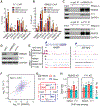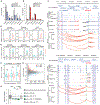Pervasive Chromatin-RNA Binding Protein Interactions Enable RNA-Based Regulation of Transcription
- PMID: 31251911
- PMCID: PMC6760001
- DOI: 10.1016/j.cell.2019.06.001
Pervasive Chromatin-RNA Binding Protein Interactions Enable RNA-Based Regulation of Transcription
Abstract
Increasing evidence suggests that transcriptional control and chromatin activities at large involve regulatory RNAs, which likely enlist specific RNA-binding proteins (RBPs). Although multiple RBPs have been implicated in transcription control, it has remained unclear how extensively RBPs directly act on chromatin. We embarked on a large-scale RBP ChIP-seq analysis, revealing widespread RBP presence in active chromatin regions in the human genome. Like transcription factors (TFs), RBPs also show strong preference for hotspots in the genome, particularly gene promoters, where their association is frequently linked to transcriptional output. Unsupervised clustering reveals extensive co-association between TFs and RBPs, as exemplified by YY1, a known RNA-dependent TF, and RBM25, an RBP involved in splicing regulation. Remarkably, RBM25 depletion attenuates all YY1-dependent activities, including chromatin binding, DNA looping, and transcription. We propose that various RBPs may enhance network interaction through harnessing regulatory RNAs to control transcription.
Keywords: RBP-TF co-occupancy; RNA-based transcriptional control; RNA-binding proteins; YY1-mediated DNA looping; chromatin binding; functional genomics.
Copyright © 2019 Elsevier Inc. All rights reserved.
Conflict of interest statement
DECLARATION OF INTERESTS
The authors declare no competing financial interests.
Figures






References
-
- Aso T, Vasavada HA, Kawaguchi T, Germino FJ, Ganguly S, Kitajima S, Weissman SM, and Yasukochi Y (1992). Characterization of cDNA for the large subunit of the transcription initiation factor TFIIF. Nature 355, 461–464. - PubMed
-
- Baltz AG, Munschauer M, Schwanhäusser B, Vasile A, Murakawa Y, Schueler M, Youngs N, Penfold-Brown D, Drew K, Milek M, et al. (2012). The mRNA-bound proteome and its global occupancy profile on protein-coding transcripts. Mol. Cell 46, 674–690. - PubMed
Publication types
MeSH terms
Substances
Grants and funding
LinkOut - more resources
Full Text Sources
Molecular Biology Databases
Miscellaneous

